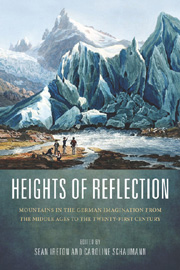 Heights of Reflection
Heights of Reflection Book contents
- Frontmatter
- Contents
- Acknowledgments
- Introduction: The Meaning of Mountains: Geology, History, Culture
- Prelude: Classical Mountain Landscapes and the Language of Ascent
- Part I First Forays: Mountain Exploration and Celebration from the Middle Ages to the Eighteenth Century
- Part II Beckoning Heights: Summits Near and Far in the Nineteenth Century
- Part III Modern Expeditions and Evocations: Climbing from the Twentieth into the Twenty-First Century
- Works Cited
- Notes on the Contributors
- Index
Introduction: The Meaning of Mountains: Geology, History, Culture
Published online by Cambridge University Press: 05 February 2013
- Frontmatter
- Contents
- Acknowledgments
- Introduction: The Meaning of Mountains: Geology, History, Culture
- Prelude: Classical Mountain Landscapes and the Language of Ascent
- Part I First Forays: Mountain Exploration and Celebration from the Middle Ages to the Eighteenth Century
- Part II Beckoning Heights: Summits Near and Far in the Nineteenth Century
- Part III Modern Expeditions and Evocations: Climbing from the Twentieth into the Twenty-First Century
- Works Cited
- Notes on the Contributors
- Index
Summary
Mountain” is a relative and variable concept, not only across the diverse cultures of the world but also in geoscientific terms. As products of tectonic, volcanic, glaciological, gravitational, and meteorological forces, mountains continually form and deform all over the globe. What were once the highest summits on the planet are now reduced to weathered mounds, as attested for instance by the Appalachians or the even older Laurentians. On the other hand, geologically younger ranges such as the Alps, Andes, and Himalayas continue to rise. While mountain elevations are generally determined from sea level, the Hawaiian Islands contain the tallest peaks in the world if one measures them from the ocean floor. Mauna Kea officially stands at 4,205 meters or 13,796 feet above sea level but rises over 10,000 meters or 33,000 feet from its base in the Pacific Ocean; it therefore surpasses Mt. Everest (8,848 m/29,029 ft.) in height. The neighboring Mauna Loa (4,170 m/13,680 ft.), the largest volcano on earth in terms of sheer mass, has depressed the sea floor some five miles, thus attaining approximately 17,000 meters or 56,000 feet in total elevation. It can therefore be considered the frontrunner in long-standing debates about mountain altitudes. But nothing is clear-cut when it comes to the earth's complex geomorphology. Owing to the imperfect sphere of our planet or its so-called “equatorial bulge,” the summit of Chimborazo (6,310 m/20,702 ft.), located only one degree south of the equator, is farther removed from the earth's center than either Everest or the Hawaiian volcanoes.
- Type
- Chapter
- Information
- Heights of ReflectionMountains in the German Imagination from the Middle Ages to the Twenty-First Century, pp. 1 - 19Publisher: Boydell & BrewerPrint publication year: 2012
